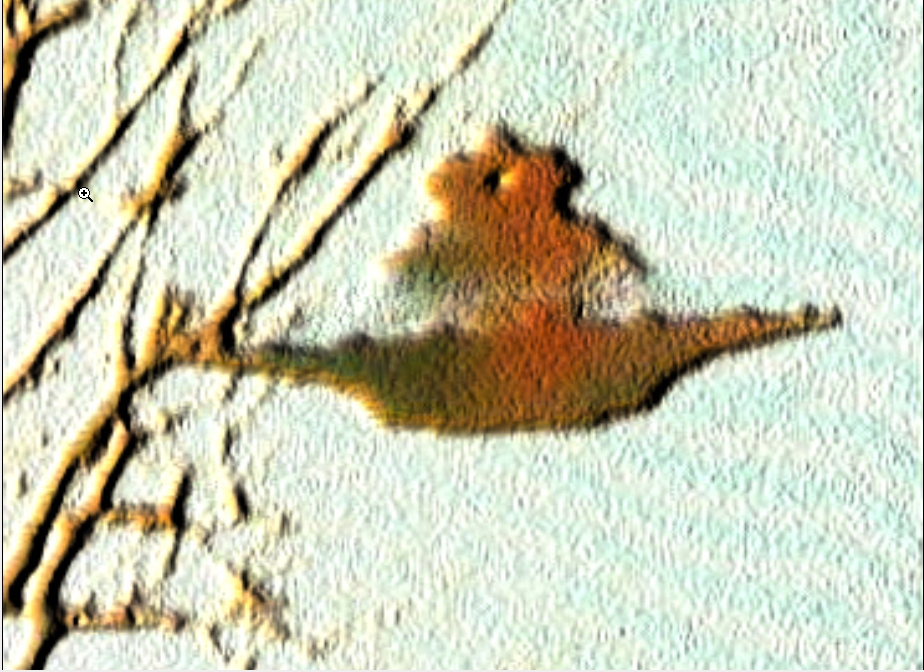 |
| Fig. 1. Meier's photo #164. The sun is believed to lie behind the right-hand side of the craft. From Stevens’s “Best of Meier UFO photos,” vol. 4 (CD). |
Although Stevens’s copy of photo #164 was only one generation removed from Meier’s original, other prints more available to the public were further generations removed. So this “smoking gun” of the Meier case, one of many, has lain smoldering. However, from an enlarged view of the craft and tree, a rather strong case can be made that Stevens and others on his investigating team were correct.
 |  |  | ||
| Fig. 2a. Blow-up of a section of Fig. 1. | Fig. 2b. Enlargement from photo #164 from Moosbrugger's ...und sie fliegen doch! (1991) as examined by Jeroen Jansen. | Fig. 2c. Fig. 73 from Korff's Spaceships of the Pleiades (Prometheus Books, 1995). |
Because of a presentation of the same scene by Kal Korff, however, shown in Fig. 2c above, an outcome of hoax has seemed certain to some. In his analysis, automatic edge-enhancement processing was performed, in which the upper sides of significant edges are automatically marked white, the undersides black, and the rest is portrayed in grey. Due to lack of contrast, the limbs in front of the craft’s dark underside do not show up, but the unwitting viewer is led to think they should show up strongly there if it weren’t a model UFO in front of the tree. (Other faint limbs, even with sky background, are not visible in Fig. 2c due to the program’s threshold for edge detection being insufficiently sensitive.) Thus the claim of a Meier-case hoax due to this presentation by Korff is still heard in some quarters.
Actually, any apparent absence of limbs in front of the craft is not nearly as significant as the presence of a limb in front, in determining hoax or no-hoax for this trio of photos. That is because the scene in the immediate vicinity of the craft and bright sky surrounding it was rather washed out due to camera glare. Meier's photo #159 shows the same tree about the same distance away but off to the side, when his camera was directed 28° more to the left (south), and out of the sun's glare, compared with Fig. 1. The tree's image in #159 exhibits two or three times more total limb substance than is seen in #164. Absence of evidence in these sun-glare photos is thus not necessarily evidence of absence. In the trio of photos with the sun behind the craft some slim outer limbs were washed out in their entirety, others appear in broken segments.
Fresh insight on these photos comes from close examination of the other two photos of the trio taken at about the same time. When Meier took photo #175, a section of which is shown in Fig. 3 below, the craft's forward facing edge was tilted downwards about 8° relative to Fig. 1 or 2a. (See also the overall scene or a cropped version of higher resolution.) This greatly extends the amount of the sloping saucer-rim surface exposed to view, and gives more contrasting background for certain faint tree limbs on the left.
 | |
| Fig. 3. Cropped from Meier's #175, in UFO...Contact from the Pleiades, vol. 1 (1979), p. 44. Dashed lines added. |
 |
| Fig. 4. Analysis by Sean Gibbons, H.Dip. Digital Media. Meier's #175 bump mapped on image manipulation program 'Gimp'. |
 |
| Fig. 5. . Cropped from Meier’s photo #174 available from Michael Horn's web site. Black circle on left is centered around the partially eclipsed far-left protuberence. Pointed out by Jeroen Jansen. |
There should now (as of March, 2009) be little doubt of the genuineness of this trio of Meier’s photos. One does not need the originals in showing this, although the lower the generation of the print, the better. The craft was on the far side of the tree, whose existence and location when in leaf has been documented. The tree was about 150 ft away from the camera.
Meier’s other 31 surviving photos of this series, which show the very same beamship at greater distances from the camera and exhibit the expected haze effect, must then also be genuine.
Once this is realized, an even more amazing realization is that the UFO pilot, Semjase in this instance, was so skillful and creative in supplying Meier with photo opportunities that would not force negative skeptics and ufologists alike to accept the intolerable. This strategy, of plausible deniability, is seen throughout the Meier case and the UFO phenomenon as a whole; it allows the aliens involved to make their existence, presence and messages for us known to those who can accept it while not prematurely disrupting the UFO coverup.
No comments:
Post a Comment